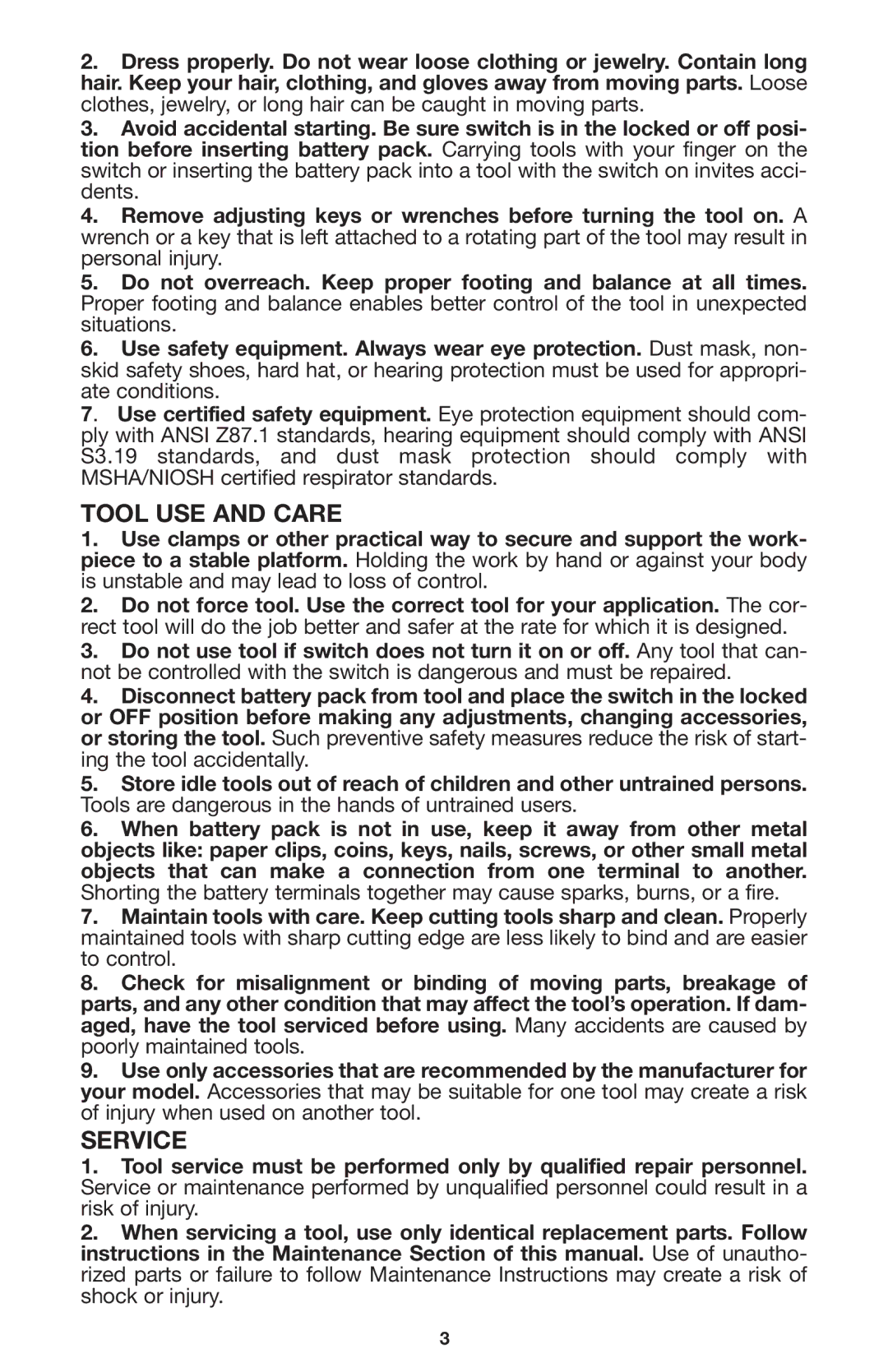2.Dress properly. Do not wear loose clothing or jewelry. Contain long hair. Keep your hair, clothing, and gloves away from moving parts. Loose clothes, jewelry, or long hair can be caught in moving parts.
3.Avoid accidental starting. Be sure switch is in the locked or off posi- tion before inserting battery pack. Carrying tools with your finger on the switch or inserting the battery pack into a tool with the switch on invites acci- dents.
4.Remove adjusting keys or wrenches before turning the tool on. A wrench or a key that is left attached to a rotating part of the tool may result in personal injury.
5.Do not overreach. Keep proper footing and balance at all times. Proper footing and balance enables better control of the tool in unexpected situations.
6.Use safety equipment. Always wear eye protection. Dust mask, non- skid safety shoes, hard hat, or hearing protection must be used for appropri- ate conditions.
7.Use certified safety equipment. Eye protection equipment should com- ply with ANSI Z87.1 standards, hearing equipment should comply with ANSI S3.19 standards, and dust mask protection should comply with MSHA/NIOSH certified respirator standards.
TOOL USE AND CARE
1.Use clamps or other practical way to secure and support the work- piece to a stable platform. Holding the work by hand or against your body is unstable and may lead to loss of control.
2.Do not force tool. Use the correct tool for your application. The cor- rect tool will do the job better and safer at the rate for which it is designed.
3.Do not use tool if switch does not turn it on or off. Any tool that can- not be controlled with the switch is dangerous and must be repaired.
4.Disconnect battery pack from tool and place the switch in the locked or OFF position before making any adjustments, changing accessories, or storing the tool. Such preventive safety measures reduce the risk of start- ing the tool accidentally.
5.Store idle tools out of reach of children and other untrained persons. Tools are dangerous in the hands of untrained users.
6.When battery pack is not in use, keep it away from other metal objects like: paper clips, coins, keys, nails, screws, or other small metal objects that can make a connection from one terminal to another. Shorting the battery terminals together may cause sparks, burns, or a fire.
7.Maintain tools with care. Keep cutting tools sharp and clean. Properly maintained tools with sharp cutting edge are less likely to bind and are easier to control.
8.Check for misalignment or binding of moving parts, breakage of parts, and any other condition that may affect the tool’s operation. If dam- aged, have the tool serviced before using. Many accidents are caused by poorly maintained tools.
9.Use only accessories that are recommended by the manufacturer for your model. Accessories that may be suitable for one tool may create a risk of injury when used on another tool.
SERVICE
1.Tool service must be performed only by qualified repair personnel. Service or maintenance performed by unqualified personnel could result in a risk of injury.
2.When servicing a tool, use only identical replacement parts. Follow instructions in the Maintenance Section of this manual. Use of unautho- rized parts or failure to follow Maintenance Instructions may create a risk of shock or injury.
3
